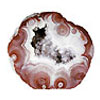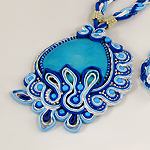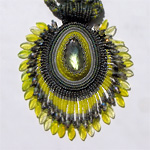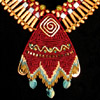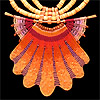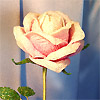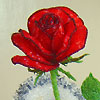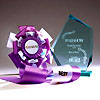May, 2010

From MyLovelyBeads.com TeamBefore you go for summer vacation, have fun! We guess, it's not late to read the May's issue of MyLovelyBeads.com newsletter:
Multicolor agate
Contact us with any questions at
info@mylovelybeads.com.
Fashion Colorworks 2010 Featured artist - Joan Babcock Renaissance jewelry Beaded roses by Alex Kramarenko Step by step - St. Petersburg chain June upcoming events Best regards,
MyLovelyBeads.com Team |
Multicolor agateAgate is a term applied not to a distinct mineral species, but to an aggregate of various forms of silica, chiefly chalcedony. Often agate coexists with layers or masses of opal, jasper or crystalline quartz due to ambient variations during the formation process. Coral, petrified wood and other organic remains or porous rocks can also become agatized. Agatized coral is often referred to as Petoskey Agate or stone. Major varieties: Arizona Striped Agate: this stone is a striped agate from the southwestern USA. Banded Agate: the bands in this stone are generally simple and clean. Gray, white and shades of red are common naturally-occurring colors. Green, yellow and black also occur naturally, or can be enhanced by a variety of treatments. Blood Agate (Red Agate, Pigeon Blood Agate): this variety of agate displays a combination of milky white and a blood red with yellow or black inclusions. Blue Agate: agate of blue, often bright color. Often is used dyed. Blue Lace Agate: agate with medium blue, light blue and white, finely bands in a lacy or wavy pattern is known by this name. It is said to lighten situations and nurture maternal impulses. Botswana Agate: this agate hails from the African country Botswana. It has a gray background, banded with fine, parallel lines of brown, light gray, tan, mahogany, pink and white, this gemstone may be almost mined out. Brazilian Agate: it occurs in brownish tones interlayered with white and gray. It is often dyed in various colors for ornamental purposes. Butterscotch Agate (Yellow Jade): agate of butterscotch yellow color; looks like yellow jade. Condor Agate: this stone comes from a difficult-to-reach 7,000-foot elevated plateau in Patagonia, Argentina, discovered in 1992. The agate's bright reds and yellows are made even more vivid by their contrasting bands of cooler, more-subtle hues. |
||||||
Fashion Colorworks 2010Just about two weeks to go! It's not late yet, the contest continues, and you can submit your entries for the Fashion Colorworks 2010 Beading Contest. June 15 is the last day. We are looking forward to seeing your amazing beaded objects at the contest!
|
||||||
Joan Babcock's macrame obsession
Any media can be used for making jewelry. Joan Babcock lives in Santa Fe, New Mexico, and her choice is fiber and beads. Joan's bright, multicolor, and sunny pieces make all art lovers admire her artworks. Joan Babcock first took up macrame when she was a teenager in Florida. It was during the tie-dye and flower power days and macrame was considered way cool back then. Her first pieces were necklaces of waxed cord and wooden beads and watchbands that she sold to a "head" shop on Miami Beach. Joan made large wall hangings of shells and driftwood and she also made a few jute plant hangers and owls, some of which still hang in her garage. After Joan moved to Santa Fe in 1986, she walked into a weaving shop called Handwoven Originals and saw some jewelry by the late artist Tina Depuy. Joan recognized her technique as macrame, but made on a much finer scale and with a contemporary look very different from the clunky jute and wooden beads of my teenage years. She knew right away that she wanted to play around with cords and beads again. Creating "micro-macrame" jewelry is a bit of an obsession but also Joan's form of meditation. She often use the "Cavandoli Knotting" technique to create pieces that resemble little woven tapestries. Other pieces are more sculptural, like her "Seashell Series". Joan love to make things that are intricate and detailed. She also enjoy working in metal and wire and incorporating them into her designs. It's Joan's hope that her work will counter some of the dismissive opinions associated with the craft of macrame. For the last few years, she has been teaching workshops in her studio and at bead shows, and shops around the country. Joan has also written two books and a DVD about micro-macrame jewelry. You can see Joan's jewelry, books and kits online in our gallery as well as at her website.
Full article by Joan Babcock
|
||||||
Renaissance jewelryThe Renaissance was a vibrant cultural movement that occurred across Europe roughly between 1300 and 1600. The word "Renaissance" is the French word for "rebirth". It originated in Italy and turned cultural focus away from the strict values of the Medieval period to a reworking of the classical Greek and Roman virtues, it was a time of rebirth of humanism and new discoveries in fine arts, music, literature, philosophy, science and technology, architecture, religion and spirituality. Key characteristics of Renaissance art include realistic linear perspective, emphasis on the relationship between light and shadow and a glorification of nature and the human figure. It is possible that one historical event had more to do with the change in the design of jewelry than any other. This was the discovery of the new world. It was from these lands that the great variety of animals were brought back to stir the jewelers and buyers imaginations. Another discovery helped to originate the title of "the jewel age" for the renaissance. This was the conquering of Peru and Mexico, for it was there that gold and silver were found in greater quantities then had ever been known. With the findings of the Incas and the Aztecs, the rulers of Europe were able to have the most spectacular jewels made regardless of the amount of rare metal needed. If any form of jewelry was chosen for the reason that is outshone all other forms during the renaissance, it would have to be the pendant. The pendant expressed the mental concepts of the renaissance. It took a multiplicity of forms and embodied many significances. The large irregularly shaped pearls, known as baroque pearls, were extremely popular. Due to this widespread acceptance, these pearls were often used as the center of design. The inspiration of antiquity did not only take hold of the medieval mind, but also that of the renaissance. A problem of design occurred due to the lack of knowledge about the jewels of Greek of Rome, for their jewels were practically unknown. Antique cameos were collected and imitated, but most of these were made during the revival of the middle ages. The fashion for cameos spread quickly, but their work never surpassed that done by the medieval craftsman. The renaissance's contribution to the history of jewelry was also its vivid colors. Jewelry became spectacularly eccentric with the use of baroque pearls, enamels, faceted diamonds and colorful stones. It was this bestowal that has made the greatest influence on future jewelry craftsmen and collectors. |
||||||
Beaded roses by Alex KramarenkoThe second our guest today is a man, that makes beaded flowers, to be exact, roses. Alexandr Kramarenko lives in Ryazan, Russia, and his late passion is beadwork. Alexandr says, "Now, having become an experienced and calm person, I know for sure what to do. Beaded flowers are the main aim and only enjoyment in my life. The world mustn't be gray! The rest of my life I'll spend in the search of beautiful forms, in the endless play of volume and color. Everything that has been before is denied. Now I'm a free gardener who quickly and smartly grows beaded roses. After a long quest a joyful, unearthly way is found. A mid-size rose takes approximately 15 hours. But I make a rose step by step in a few days. At the same time I work at other things. Each rose is different. You are looking for new lines, forms, color. Today I've got a real collection of various kinds of roses. The search for a compromise and harmony in everything: in the construction, color, and form. The aim of art according to Shakespeare is putting a mirror in front of nature or "to measure harmony with the help of algebra," as a Russian writer A.Pushkin said. I often measure real roses with a ruler. It's difficult to find the idea of composition. Sometimes it flies down from the heavens as an inspiration. Once I saw a picture by S.Dali "A nude woman is looking at her body at the old age." You may place two roses near each other - an old one and a young one. Once I made a composition "An American Steve presents Good to Russian children." The base of the composition is a circle that means grimy grounds, in other words, unbearable Russian reality. The kids from the orphanage are standing around like tiny flowers. Steve as a big flower is in the center. The golden beaded rays from him are running up and down to the hearts of little flowers. Steve has taken this composition to the US. He said that a hobby of making beads is good for children in their spare time..."
Full article by Alex Kramarenko
|
||||||
Step by step - St. Petersburg chain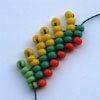
Today we publish a tutorial by Victoria Katamashvili on St. Petersburg chain stitch, one of the most interesting techniques. Learn it, and the next month tutorial will be a variation of St. Petersburg chain, that can be used for creating exciting pieces of beaded jewelry. |
||||||
Upcoming events
June 6 - June 13, 2010 Do you love fashion and jewelry? Do you have a passion for beautiful accessories? The Bead & Button Show is the largest jewelry and bead show in the nation. Over 370 vendors will be selling one-of-a-kind finished jewelry plus precious gems, pearls, art beads, gold and silver, beading supplies and books. The show will also feature a juried exhibit Bead Dreams 2010 of inspiring bead art and over 500 bead and jewelry classes. |
||||||
Note
If you don't see the newsletter properly formatted please click here:
May Issue
|
||||||
© 2010 MyLovelyBeads.com All Rights Reserved.
If you do not want receive our newsletter and you wish to remove your email address from our mailing list, please click the following link to unsubscribe.



